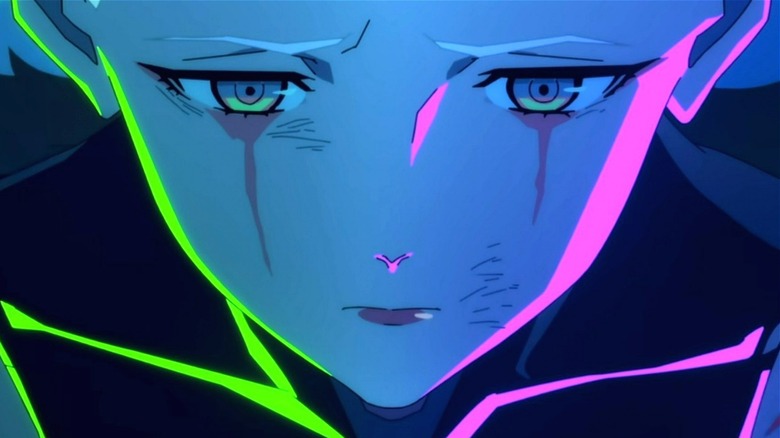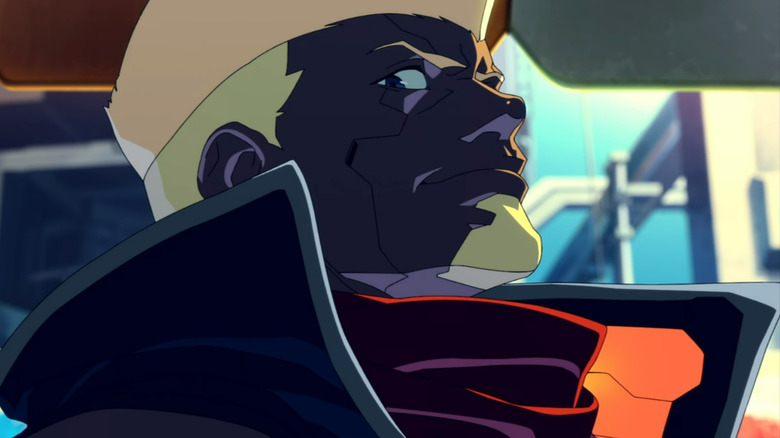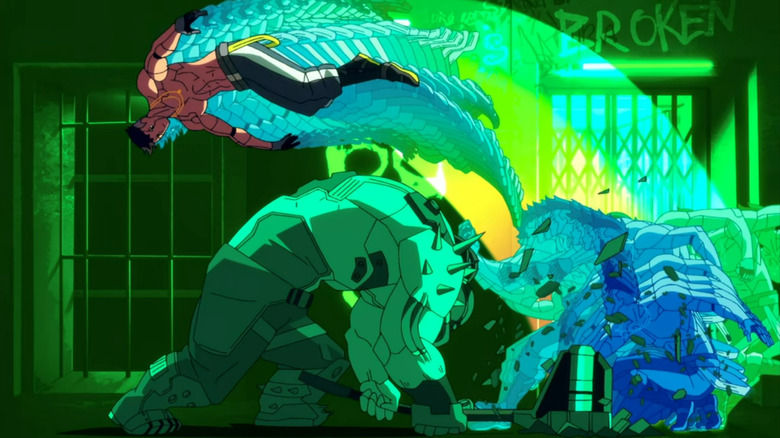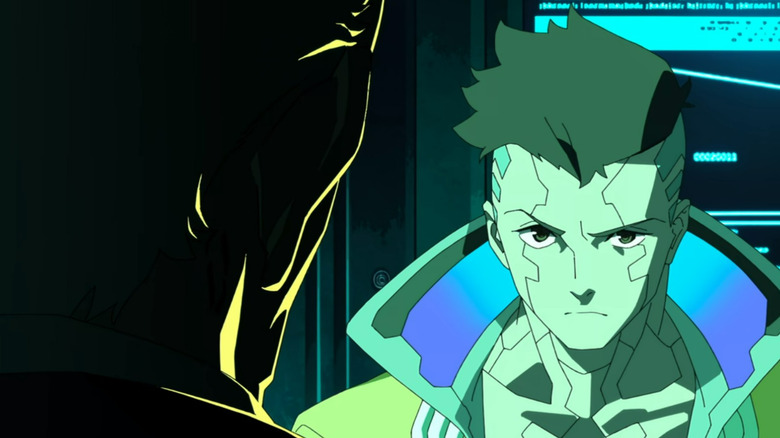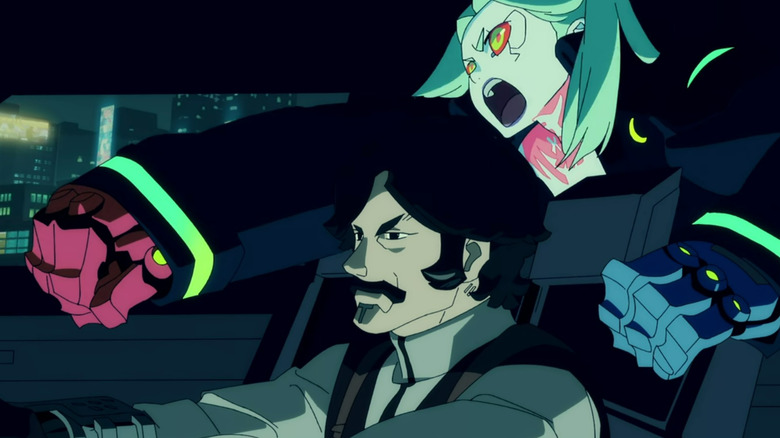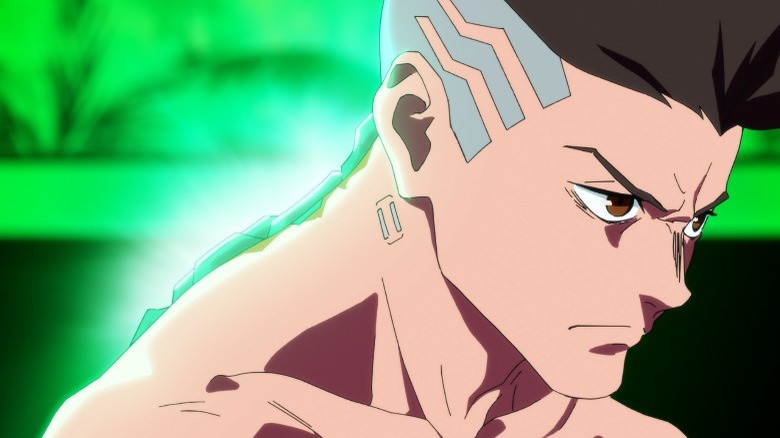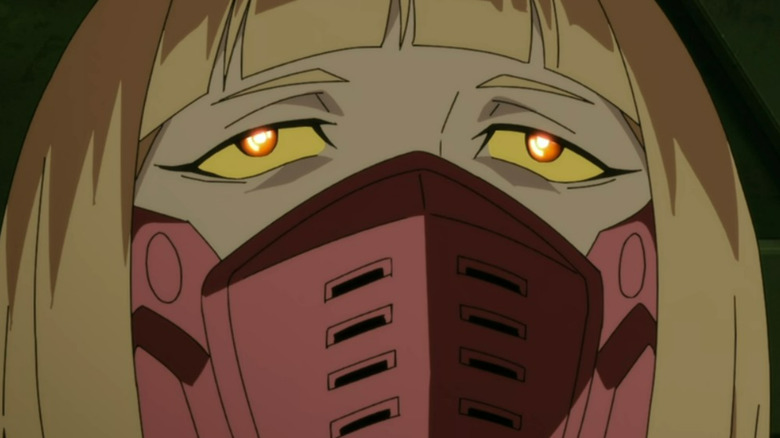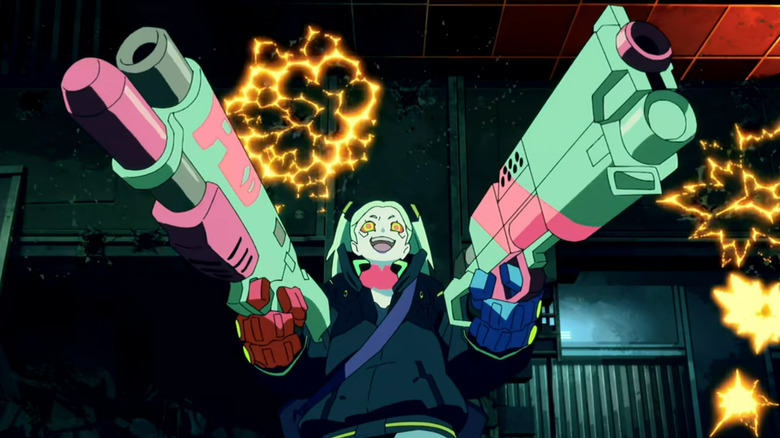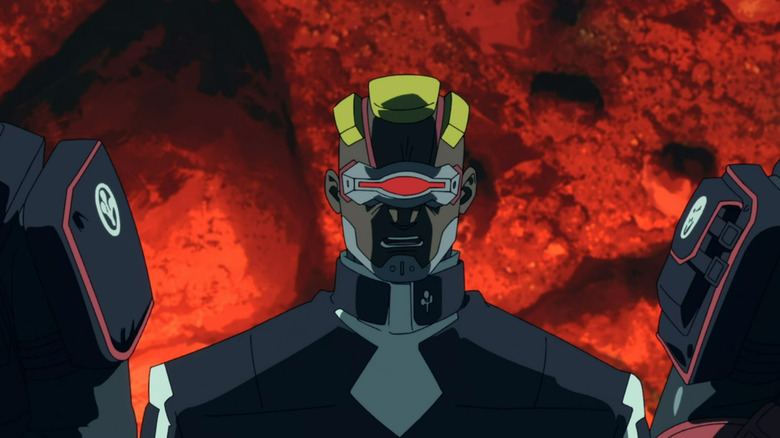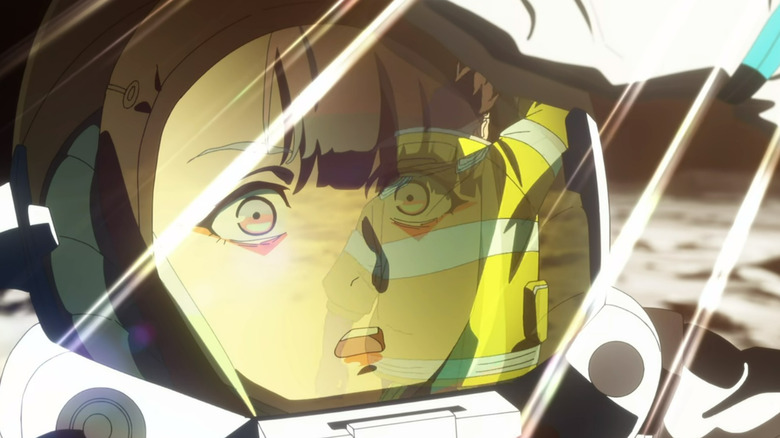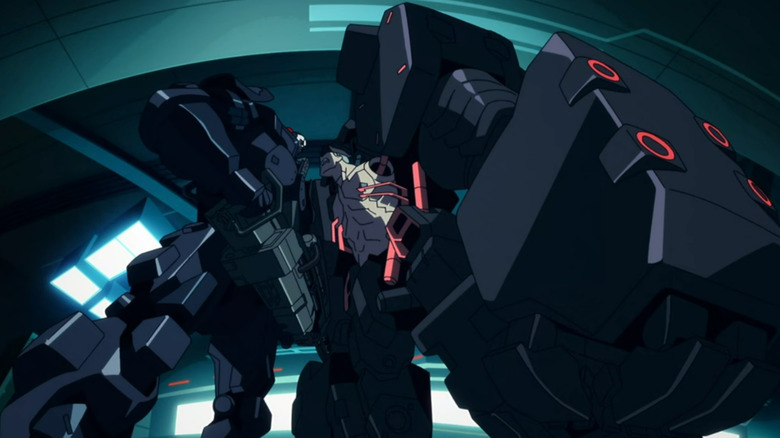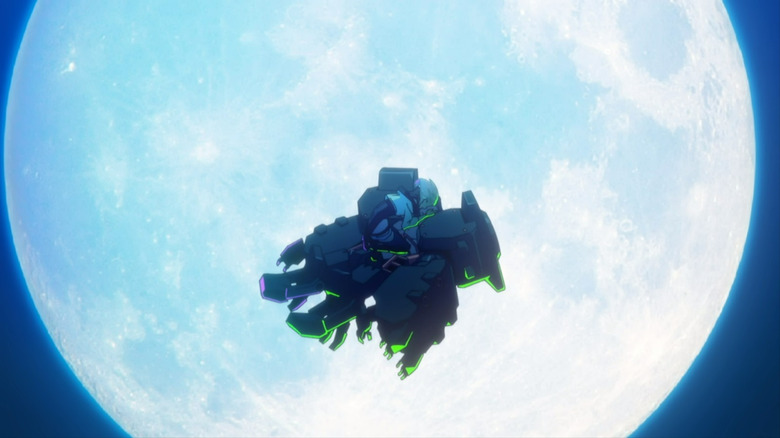The 6 Best And 6 Worst Things About Cyberpunk: Edgerunners
"Cyberpunk: Edgerunners" is a curious show, one that is at the same time incredibly familiar and wholly new. Based on Mike Pondsmith's tabletop role-playing game — and by extension the video game "Cyberpunk 2077" from CD Projekt Red — the 10-episode series tells a self-contained story of struggle and tragedy within the iconic setting of Night City. The show's blend of anime sensibilities (courtesy of Studio Trigger), neon style, and strict adherence to the neo-noir genre have earned it widespread praise, both from critics and from viewers on Netflix.
At face value, "Edgerunners" is the exact kind of story you'd expect to see told in the "Cyberpunk" universe. The transformation of lead protagonist David Martinez from a poor kid with no prospects to a chromed-up mercenary features all the hallmarks of the genre, from the inescapable pessimism to the ever-watchful eyes of the world's corporate overlords. Much is made of the risks of cyber augmentation, the dangerous nature of life on the streets, and the vast class divide that defines Night City. It's nothing you haven't seen before, but it's all pulled off incredibly well.
Despite its crystalline review scores, "Edgerunners" isn't a perfect show. Season 1 squeezes a ton into its 10 brief episodes, and it doesn't pull all of it off. What the show does deliver, however, is well worth the time spent watching it. Here are the best and worst things about "Cyberpunk: Edgerunners."
Be warned — there will be major spoilers ahead.
Worst: Tropes, tropes, tropes
As a genre, cyberpunk is about as tropey as it gets. It's such a specific kind of worldbuilding and storytelling that many things are bound to be the same across franchises. Mega-corporations, classism, neon, street gangs, tech slang, graffiti, and an overwhelming sense of inevitable tragedy — these are the callings cards of the genre. And yes, they're all present in "Cyberpunk: Edgerunners" as well.
That said, tropes aren't necessarily bad. Quite the contrary, cyberpunk is a kind of fiction that many people gravitate toward specifically because it's familiar. Of course, David has to jump into a pile of trash to get to school every day. Of course, the mysterious netrunner has dreams of going to the moon. Of course, the mercenary who becomes a father figure to our hero goes out in a blaze of glory. After all, it's cyberpunk. These are just the things that happen.
While there is a kind of satisfaction in seeing events play out exactly the way you know they will, the loyalty "Cyberpunk: Edgerunners" has to genre tropes works against it at times. Things feel incredibly predictable because we've seen most of the story beats play out numerous times in other movies, shows, comics, and games. As a result, the show can feel more like a gorgeously animated roleplaying campaign than a story written uniquely for the screen. Although, in fairness, that's kind of the point — and no roleplaying campaign ever looked this good.
Best: Stunning aesthetics
Let's get the best part of "Cyberpunk: Edgerunners" out of the way — the animation. Studio Trigger has a field day with the 10 episodes of Season 1, painting a striking canvas of neon and chrome that somehow finds new ways to impress with every episode. The character designs are all inspired and immediately memorable, from main characters like David and Lucy to supporting figures like Rebecca and Kiwi. Every shot in Night City is packed with details, such as the subway maps on the windows of the trains and the bold billboards proclaiming the power of the different corporations.
That's just the art. "Cyberpunk: Edgerunners" is full of shots that would still impress as still images, but it's even more stunning when things are in motion — especially David himself. The Sandevistan implant that becomes David's trademark has one of the coolest-looking super-speed effects ever animated, which leaves a trail of neon afterimages to mark his faster-than-light movements. When these flashy moments of action collide with the beautiful artwork that brings Night City to life, "Cyberpunk: Edgerunners" becomes something truly special.
It's not just the visuals, either. The soundtrack of "Cyberpunk: Edgerunners" is nearly as enrapturing, with Franz Ferdinand's "This Fffire" serving up the perfect lead-in for every episode. The other songs — lyrical and instrumental alike — help to construct the thick atmosphere of Night City, making it a place you never want to leave, despite all the horrible things that happen there.
Worst: Too edgy at times
It's no secret that cyberpunk isn't exactly the most wholesome or kid-friendly genre out there. It's a sect of fiction where society is typically broken, depravity is often commonplace, and people die by the cyber-truckload. As such, it stands to reason that "Cyberpunk: Edgerunners" would get pretty risque at times. Still, the show's emphasis on just how dark and serious things are can be distracting.
This is particularly true in the earlier episodes of the season. David's tragic fall from a promising student to a desperate orphan on the streets happens in just about 20 minutes of screen time, which makes it feel a bit contrived. We get it — Night City is a terrible place where life's never fair and bad things happen to good people for no reason. The kid never even had a chance, did he? Pass out, wake up, what's the difference? Just one more day in this godforsaken cyber-city.
Fortunately, once the show gets going, it turns this edgy tone to its advantage. The other characters balance things out, turning what could have been a preachy and heavy-handed story into delicious pulp. The cliches don't stop coming, and Night City doesn't get any brighter, but "Cyberpunk: Edgerunners" finds the fun a few episodes in and never lets up. Ultimately, that's its saving grace.
Best: Great characters
In Episode 1 of "Cyberpunk," the only major characters are David and his mom. Episode 2 is all about David and Lucy. However, once the rest of Maine's crew enters the picture, things get a lot more dynamic and a lot more fun. Kiwi, Dorio, Rebecca, Falco, and the rest of the supporting cast are all great, and you quickly come to love them despite the lack of direct character development.
The world of "Cyberpunk" is one where people don't volunteer details about their pasts, and "Edgerunners" uses that to its advantage. We might not learn all that Kiwi has experienced in her life, but when she makes tough decisions, we get that she's doing so from an incredibly jaded place. Rebecca's chaotic and violent persona is endlessly entertaining to watch, but we also see glimpses of the person beneath all the bullets and chrome. Beyond that, memorable villains like Faraday and Adam Smasher round out the cast nicely.
Most of the characters in "Edgerunners" are mildly modified archetypes. There's the boastful bruiser, the shady swindler, the too-old-for-this survivor, and the philosophical hacker. While they may not be terribly original, they interact with each other in organic and compelling ways. The show does an excellent job of convincing you that everyone has a relationship with everyone else, even though some characters barely talk. As a result, the world feels much more real and lived-in.
Worst: Not enough time
Clearly, "Cyberpunk: Edgerunners" Season 1 is incredibly economical in its storytelling. It makes you care about a ton of characters in just 10 short episodes, and it's very efficient in the ways it develops those characters. Still, that doesn't take away the sting when the season ends with so much potential left untapped.
Make no mistake — "Cyberpunk: Edgerunners" is fantastic at the length that it is. In fact, it's more of a commentary on how great the show is that the 10 episodes end up flying by so quickly. David and Lucy's story is perfectly encapsulated in Season 1, but it's hard not to feel like the show is just getting started by the time credits roll on the finale. Most of the main characters don't make it, and while that's partially because of the grim tone of the show, it also feels a bit like the result of having too little time. In other words, the characters and the world of "Cyberpunk: Edgerunners" are vibrant enough to support twice as many episodes, but in the interest of keeping things contained, every plot thread is rushed toward the same bloody conclusion.
Again, your mileage may vary on the pacing of the show. Certain aspects of the story benefit greatly from the rapid momentum, but some suffer. It's easy to love the version of "Cyberpunk: Edgerunners" that we have, but it's also hard not to envision what a version with more room to breathe might have looked like.
Best: Keeping it simple
Lament as we may about all the things that don't get explored in "Cyberpunk: Edgerunners," there is an undeniable elegance in the show's simplicity. David is the main character, and he remains the main character for the duration of Season 1. Everyone else enters and exits the story through their relationship with him, and when his arc comes to an end, so does the series.
By orbiting all other aspects of the story around David, "Cyberpunk: Edgerunners" is able to focus most of its energy on telling his tale as effectively as possible. Each episode embraces a familiar but distinct format, marking a different chapter in David's journey. Episode 4, "Lucky You," is a standout in that regard, taking a montage approach to showing how David gradually becomes part of Maine's crew. The time-jump-preceded Episode 7, "Stronger," is similarly effective.
If you ever did a plot structure worksheet in the 8th grade, you can probably predict the big-picture beats of "Cyberpunk: Edgerunners." It follows the typical three-act structure to a T — but that's one of its strengths. By the time you reach the end of "Cyberpunk: Edgerunners," the early episodes have gained new significance because of how cleanly everything fits together.
Worst: Tunnel vision
While the focus on David's story is a strength of "Cyberpunk: Edgerunners," the show does suffer a bit from tunnel vision in other areas. Night City is a massive place filled with all kinds of people and all kinds of stories, but the Netflix series funnels viewers into a pretty small subset of those early on. It's interesting to see David's daily routine in the early episodes, such as his commute to school, the way his classroom works, and the kind of work his mom does. Still, since the drama demands that he get chromed up fast, most of the show only depicts the gritty street life of night City.
Clubs, bars, and back alleys are the primary locales in "Cyberpunk: Edgerunners." Though they all pop thanks to the stunning visuals, it's a shame that we don't get to spend more time exploring other parts of the world. David's romantic scenes with Lucy are a nice change of pace, but these are reduced to a trickle in the season's second half. The core plot of the show is a pretty generic corpo war when you really look at it, but it's made exciting because the characters are so fun to watch. Sadly, in the interest of getting that corpo arc to the finish line, a lot of other things have to take a backseat.
Best: The right amount of action
In shows like "Cyberpunk: Edgerunners," there's bound to be a lot of action. Between the guns and the cyber implants, most of the characters are basically walking weapons, and they get plenty of opportunities to show off their combat skills. However, "Cyberpunk: Edgerunners" smartly paces out the big action sequences, which only makes them more impactful when they happen.
Early in the season, we're told that David shouldn't use his Sandevistan too frequently, as it takes a massive physical and mental toll. Though he proves that his tolerance for cybernetics is astronomically high, the toll of using those abilities is always painfully clear. For that reason, it adds to the drama of the show that there's only occasional action. Every time he pops the Sandy, it's a double-edged sword of excitement and tension. These are the show's most visually striking scenes, but they also carry heavy ramifications for David.
Spreading out the action makes every fight matter. It also raises the stakes because you know that any major firefight could end with a main character biting the dust. Maine's last stand, David's Militech onslaught, the final duel with Adam Smasher — all of these fights stand out because they're distinct. At the same time, "Cyberpunk: Edgerunners" makes even the smaller fights feel big. Whether the gang is battling MaxTac or a random cyberpsycho on the street, it all hits hard.
Worst: No new ideas
The small details in "Cyberpunk: Edgerunners" are what make it great. The attention to detail is in the animation, the thematic parallelism, the vocal performances, and the musical choices. It's a very familiar story that's told exceptionally well. However, in choosing familiarity, the series also sacrifices its potential to break ground in the genre.
There aren't many revelations in the sci-fi elements of "Cyberpunk: Edgerunners." Corporations are bad, cybernetics are dangerous, and you can plug your brain into computers. These are all things that we've seen before, and the show does very little to explore any new ramifications of its futuristic technology. Even cyberpsychosis, the core concept at the center of the story, reads more like a roleplaying game status effect than a real interrogation of what it means to be human.
Of course, that's probably because it is a roleplaying game status effect. "Cyberpunk: Edgerunners" feels derivative because it's set in a longstanding franchise built on game mechanics. From that perspective, it's hard to hold the show's lack of new ideas against it, especially since the world it does build is so enticing. Still, it's hard not to feel like the show could have accomplished more in the genre than it attempts.
Best: The love story
Like most of the show, the love story between David and Lucy in "Cyberpunk: Edgerunners" isn't exactly original. A smart street kid catches the eye of an enigmatic hacker who introduces him to a new world — it's practically Shakespearean. Still, the love story far exceeds its derivative status.
By the end of "Edgerunners" Season 1, you'll find yourself hoping against all the odds that David and Lucy might both make it out. Maybe they'll get to the Moon together. Maybe they'll get a second chance. Every ounce of lore and foreshadowing tells us this won't be the case, but it's hard not to want it to be. In a world that's defined by tragedy and pessimism, David and Lucy's story is a sincere spark of hope that things can be better.
There's even a little bit of "The Gift of the Magi" in their saga, as they each put themselves in grave danger in the hopes of saving the other. All David wants is for Lucy to live her dream and get a fresh start. All Lucy wants is for David to live. In the end, neither character gets the ending they hoped for, but the journey there is one of the absolute highlights of "Cyberpunk: Edgerunners."
Worst: An abrupt ending
Our final gripe about "Cyberpunk: Edgerunners" isn't really a criticism — it's more of a remark on how compelling the story is by the end. David is a great protagonist, and he's surrounded by a cast of supporting characters who are every bit as fun to watch. So while the Season 1 finale does a good job of capping off the story, it's sad to know that almost no one we've come to know could return in a Season 2.
Kiwi, Faraday, Maine, Dorio, Rebecca, Pilar, Gloria, and even David (probably) are all in the ground by the time "Edgerunners" Season 1 ends. That's by design. It's clearly meant to be an independent Night City story with a definitive beginning and end, and it pulls that goal off spectacularly. Still, given how successful the show has been, it could have had a bright future ahead of it, and it's a shame that none of those characters can be a part of that future.
How positively remembered the decision to end so many storylines will depend in part on what comes next. If "Cyberpunk: Edgerunners" Season 2 comes out with all new faces and falls short of expectations, fans are likely to lament Season 1's abrupt ending even more. If Season 2 is great, then they might not mind so much.
Best: Full circle
The benefit of wrapping up a story in 10 episodes is that everything comes full circle. There's real satisfaction in watching David's story play out, even though we know it's not going to end happily. Lucy makes it to the Moon. David meets the same fate as Maine. Kiwi pays for her betrayal, and Rebecca goes down in a blaze of glory. Many of these conclusions are tragic, but they also fit perfectly with what happened earlier.
Beyond narrative wrap-ups, "Cyberpunk: Edgerunners" also has some great full-circle thematic moments. The image of David dropping into a pile of trash bags on the way to school every day foreshadows the cliff metaphor that later describes his declining mental state. He gets to climb Arasaka Tower just like his mother hoped he would, but it's before taking his final dive. Even the Sandevistan itself acts as a symbol for David's arc. Sure, you can try to slow down time, and yes, you can do a lot when you do. But eventually, all those afterimages are going to catch back up to you, and the world is going to speed up again whether you're ready or not.
As Lucy looks down on Earth from the Moon in the show's last scene, we feel her complicated emotions. She loses so much getting there, but she's also the one person who gets to break the cycle — to escape the meat grinder of Night City and get a fresh start somewhere else.
